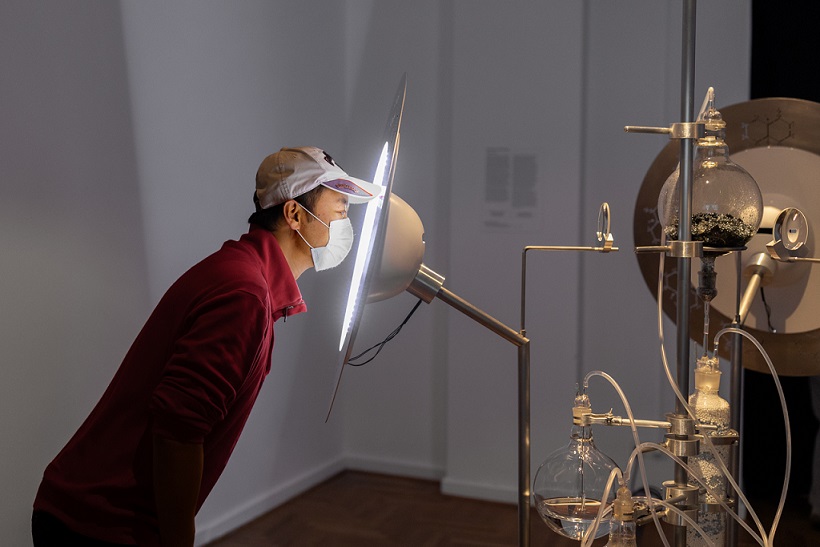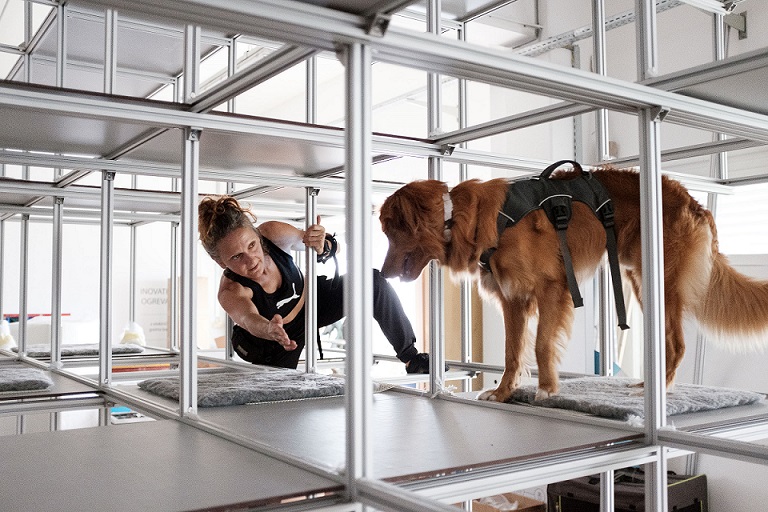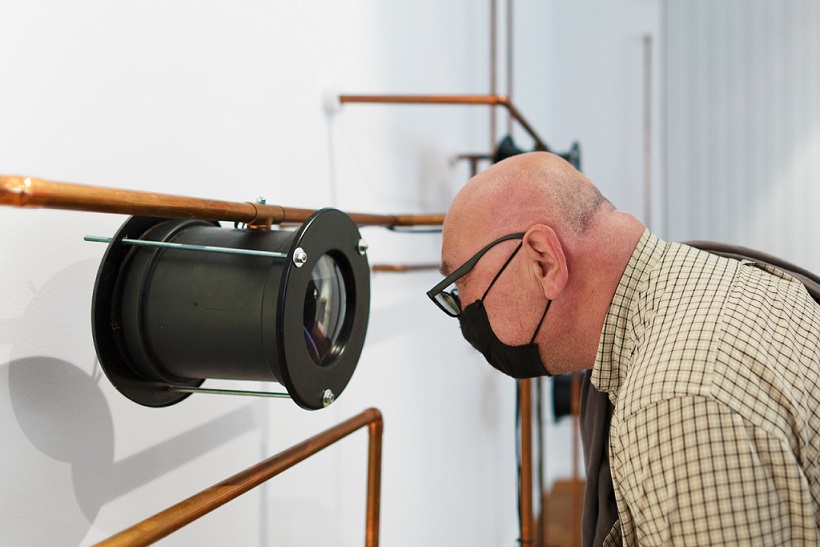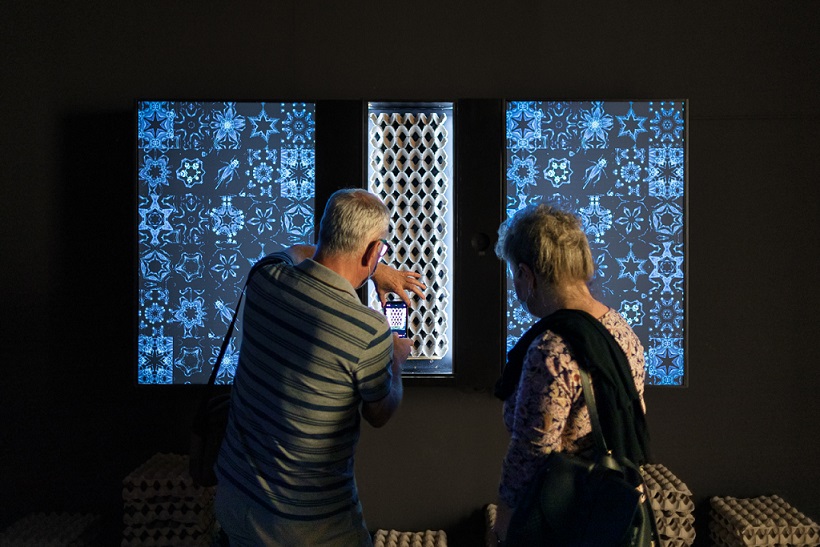The Relation Between Humans, Animals and Plants When Contemporary Technologies Penetrate All Pores of Our Lives
With their projects at Living Object, Špela Petrič, Maja Smrekar, Saša Spačal, Robertina Šebjanič and Polona Tratnik provide an insight into the relationship between humans, animals and plants in light of heterogeneity, hybridity, sympoiesis, intercognition and parallel evolutions.

An inseparable connection between the human body and the environment
By emphasising the connection between the human body and the environment, the exhibition reveals our bond with non-human actors and enables our awareness about the urgent need to take care of nature and its living systems, not only as exploitable resources, but also as living tissues that are crucial for our survival. Many of the exhibited projects were conducted in laboratories through interdisciplinary collaborations with experts in natural sciences and the humanities and they are all the result of long-term processes and research.
Meta_bolus Photo: Saša Spačal & Mirjan Švagelj, Metabolus, Ljubljana City Art Gallery © Andrej Peunik / MGML
Photo: Saša Spačal & Mirjan Švagelj, Metabolus, Ljubljana City Art Gallery © Andrej Peunik / MGML
In the Anthropocene, living and non-living substances are immersed in the planetary metabolic flow in which pharmacological doses are asymmetrically exchanged. The work shows two feedback loops of the metabolism of matter on our planet with the help of the Streptomyces rimosus bacterium, present especially in soil and mouldy vegetation. The first questions the human extraction of antibiotics from the mentioned bacteria, which inhabit Meta_bolus’s central bioreactor, while, with a process of extraction in laboratory glassware, it returns the antibiotics to the soil. Thus the bacteria circulate as a reminder that soil and dust are phases in the metabolic process that no agent on this planet is able to escape and as a warning that every metabolic flow has a particular bolus or dose that determines the relationships between the agents as beneficial or adverse.
!brute_force

Photo: Maja Smrekar, !brute_force, © Jernej Lasić
!brute_force is the title of an ongoing artistic research (2019–2021) whose aim is to create the basis for artificial intelligence that can advise humans on how to equate their heart rate with that of a dog. As part of the Living Object, Maja Smrekar will present the phase of the project titled FEEDING THE ALGORITHM, in which the artist and a dog will climb up and down the installation whose form captures the dog’s historicalness established with the human body. The form of the installation is based on the structure of the serotonin molecule, a neurotransmitter whose functions in humans were strongly affected by their life with dogs.
Skotopoeiesis

Photo: Špela Petrič, Skotopoiesis, Click Festival, 2017 © Miha Turšič
Skotopoiesis (gr. skótos – darkness) is the first project in a series. It is a 20-minute art performance piece during which the artist stands still in front of a field of germinating cress, throwing her shadow on the plants. This causes them to change their shape and colour: due to the lack of chlorophyll, they lose their green colour. This effect is triggered by phytochromes, one of the non-photosynthetic light sensors of plants. At the same time, the diminished light intensity stimulates the production of auxin, a plant hormone that acidifies the cell wall, facilitating the elongation of the stem when the plant endeavours to grow out of the shadow. While the cress elongates, the artist shrinks – due to fluid loss in the intervertebral disks, the artist’s body height decreases. The physical changes in both actors thus prove interspecies confrontation.
Aqua_forenzik

Photo: Robertina Šebjanič & Gjino Šutić, Agua_forenzik, Ljubljana City Art Gallery © Andrej Peunik / MGML
With their project that presents the findings of a research conducted on two locations, the Danube and the Adriatic Sea, the artists reveal the invisible, but ever more present pollution of the world’s waters by pharmaceutical and chemical pollutants. They are the residues of industrial production and everyday human consumption, such as legal and illegal drugs flushed down the drain. Because, on average, the human body is able to digest only 20% of the drugs that we consume, while the other 80% is disposed from our body, active substances were discovered both in waste treatment effluents and in waste waters.
37˚C

Photo: Polona Tratnik, 37˚C, Ljubljana City Art Gallery © Andrej Peunik / MGML
37˚C brings an insight into the boundaries between life and death with the help of human skin cells, which, like hair cells, contain information about an individual and are capable of division. The transfer from a human into an artificial environment, where, at 37˚C, the artist ensured the cells had the conditions for further development, reflects the artist’s research focus – the increasing role of biotechnology in obtaining power over the human body.
Transversal Is a Loop

Photo: Saša Spačal, Transversal Is a Loop, 2020, Ljubljana City Art Gallery © Andrej Peunik / MGML
The 50-minute sound composition is based on the artist’s critical consideration of the human impact on the ecosystem at the planetary and microscopic levels, which she carries out by researching sympoeisis, with a special focus on her interest in the possibility of co-creating with a non-human actor, in this case, the Acheta domesticus crickets. The work connects field recordings, sounds of a DIY string instrument, analogue and digital modular synthesizers, acoustic resonance and feedback loops for the establishment of a sound relation with crickets built without the usual hierarchy.
Admission free.